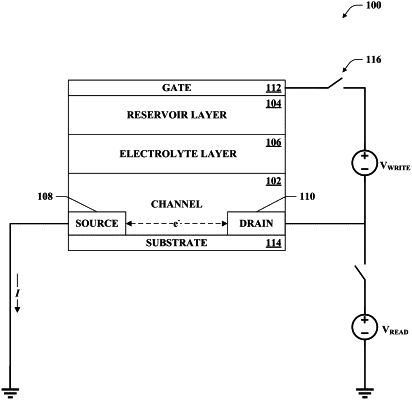| CPC H01G 9/22 (2013.01) [G11C 11/54 (2013.01); H01G 9/21 (2013.01); H01G 9/025 (2013.01); H01G 9/035 (2013.01); H01G 9/28 (2013.01)] | 20 Claims |

|
1. A device, comprising:
a solid channel layer having a variable conductance;
a source coupled to a first side of the solid channel layer;
a drain coupled to a second side of the solid channel layer;
a solid reservoir layer;
an electrolyte layer positioned between the channel layer and the reservoir layer, wherein:
when a write operation is undertaken on the device, the device is heated to a temperature above a state transition temperature and a write voltage is applied between the channel layer and the reservoir layer, conductivity of the electrolyte layer is increased with respect to ions or vacancies present in at least one of the channel layer or the reservoir layer, the ions or vacancies migrate between the reservoir layer and the channel layer by way of the electrolyte layer, and conductance of the channel layer changes responsive to the ions or vacancies migrating between the reservoir layer and the channel layer; and
when a read operation is undertaken on the device, a temperature of the device is below the state transition temperature and a read voltage is applied between the source and the drain, where the conductance of the channel layer is substantially invariant when the temperature of the device is below the state transition temperature.
|